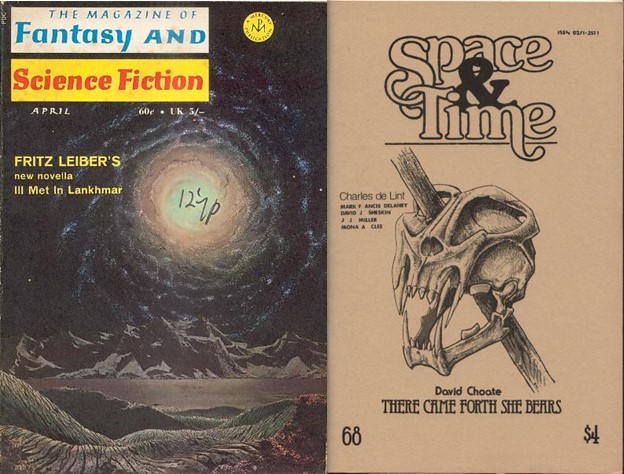Tor Double #19: Fritz Leiber’s Ill Met in Lankhmar and Charles de Lint’s The Fair in Emain Macha

Cover for The Fair at Emain Macha by Mel Grant
This volume of the Tor Double series offers something it hasn’t offered before. Although several of the novellas previously published in the series have played with the tropes of fantasy novels, such as Jack Vance’s The Last Castle or Joanna Russ’s Souls, all of the stories published to this point have been science fiction. With Volume 19, the series offers two novellas which are unabashedly fantasy, Fritz Leiber’s Ill Met in Lankhmar and Charles de Lint’s The Fair in Emain Macha. Not only are both fantasy stories, but both of them are parts of series exploring the characters who feature in them.
Fritz Leiber introduced the world to Lankhmar and his characters of Fafhrd and the Grey Mouser in August of 1939 in the story “Two Sought Adventure,” which appeared in Unknown. By 1969, he had published an additional eighteen stories about the adventurers, including one story which told of the Grey Mouser’s life before he met Fafhrd.
Ill Met in Lankhmar was originally published in F&SF in April, 1970. It won the Hugo Award and the Nebula Award. Ill Met in Lankhmar is the second of four Leiber stories to be published in the Tor Doubles series. A prequel to all of the previously published Lankhmar stories with the exception of “The Unholy Grail,” this novella tells how his two characters meet for the first time.
The story opens with two thieves, Fissif and Slevyas, robbing a gem merchant. Although their heist goes off smoothly, they are surprised when they are set upon by the Grey Mouser and Fafhrd, both of whom had separately been watching the burglary and planning on robbing the thieves after they left the gem merchant’s home. Rather than setting upon each other, the two view each other as kindred spirits and agree to split their profits.
In “The Unholy Grail,” Leiber had introduced a love interest for the young Mouser a woman named Ivrian, and she is still with him at the opening of Ill Met in Lankhmar. Fafhrd also has a love interest, Vlana, who wasn’t introduced until the story The Snow Women, which was published in Fantastic the same month as Ill Met in Lankhmar was published in F&SF. Just as Fafhrd and the Grey Mouser hit it off with each other, so, too, do Ivrian and Vlana.
Published more than thirty years after the first story, Leiber had already determined what went into a Fafhrd and Grey Mouser story. Even though this is the tale of how the two met, it is the quintessential story in the series and contains all of the common tropes that are most associated with the characters. The pair face the powerful Lankhmar Thieves Guild, the evil warlock Hristomilo, the maze of Lankhmar streets and buildings, and strange demicreatures.
Although the characters may not know each other when the story starts, Leiber knows them, and can assume the readers know them. This leads to one of the weaknesses of the story in that the two characters, destined to become the closest comrades, do not have to go through an awkward phase of getting to know each other. Once they are thrown together, they accept each other and fall into a mature relationship.
Of course, a successful heist and an established friendship don’t offer much in the way of tension or conflict so Leiber introduces Krovas, the Grandmaster of the Thieves Guild, and Flim, the Night Beggarmaster, both of whom seek vengeance against the pair in retaliation for their unauthorized thieving and impersonation of beggars. This sets up the pair subsequent relationship with the Thieves Guild in stories published both before and after Ill Met in Lankhmar.
The story has a rather melancholy ending as Fafhrd and the Grey Mouser manage to come out ahead of the various guilds, but at a great cost that leads them to flee Lankhmar for the wilderness of the Great Salt Marsh and adventures yet to be published and previously known.
Lankhmar was already a living, breathing, city by the time Leiber got around to writing this story, and that meant he knew its streets well. Even when he doesn’t provide specific details, there is the sense that there is a history that is known and an understanding of how the city works, both physically and culturally, which offers a richness to the setting.
Leiber published three stories in the series in 1970. Fafhrd’s origin story. The Snow Women, and Ill Met in Lankhmar both appeared in April, and the third, which is set following Ill Met in Lankhmar, “The Circle Curse,” appeared in July in the collection Swords Against Death. Both The Snow Women and Ill Met in Lankhmar were nominated for the Hugo Award, but Leiber declined the nomination for The Snow Women in favor of Ill Met in Lankhmar, which won the award.

Space and Time Summer 1985 cover by John Alexander
The Fair in Emain Macha was originally published in Space and Time #68 in December, 1985. It was nominated for the Aurora Award. It was de Lint’s fourth story about the life of Colum mac Donal, an outlawed man from Aerin serving King Artor of the Grey Isles. Having helped Artor (Arthur) set his kingdom to rights, Colum is ready to return to Aerin to seek his vengeance on the Ard-righ (High King) who killed his clan and declared him an outlaw, despite facing the threat of being named an outlaw by Artor as well.
Despite Artor’s friendship and threats, Colum decides he needs to return to Aerin, where he left his lover, Maeve, seven years earlier. He leaves in the middle of the night and is surprised to discover that another passenger on his ship from the Grey Isles to Aerin is Artor’s advisor Myrddin. Initially fearful that Myrddin has come to exact Artor’s vengeance on him, Colum learns that Myrddin feels that his role is to help Colum return to Aerin and overthrow the Ard-righ, Fergus.
Colum manages to connect with his clan and dyes his hair and moustache to disguise himself as they head for the titular Fair at Emain Macha. His clan’s king, Conneach, supports him and is willing to help him, even putting him into the position as champion, under and assumed name, to help support their cause. The problem, Conneach explains, is that while all of the tribes of Aerin agree that Fergus is illegitimate and needs to be overthrown, getting them to act together is a near impossible supposition.
Colum also learns that shortly after he fled Aerin, Maeve gave birth to a child. Refusing to tell her father, Fergus, who the child’s father was, Fergus has kept her imprisoned for the past seven years while the child was secreted away with a foster family of sidhe. The Fair seems like it will be the key to starting to restore the world to the way Colum would like to see it, as it is a gathering place for all the tribes and violence is forbidden during the fair.
De Lint further complicates the situation by introducing Valkings into the mix. Fergus has decided that Maeve should marry the leader of the Valkings, Guttorm, in order to seal an alliance in which the Valkings will support Fergus’s consolidation of his reign in Aerin as well as his ambitions to overthrow Artor in the Grey Isles.
Providing a slight twist to the legends of King Arthur and the history of Ireland, de Lint has created a complex situation where even erstwhile allies have their own agendas and can’t be counted out to see things in the same light. While Colum deals with the political situation raised by the design to revolt against Ard-righ Fergus. Myrddin goes in search of Colum’s fostered son and deals with the faerie world of the sidhe. Although magic is mostly downplayed, it does exist, although Myrddin’s ability to use magic is hampered by the fact that de Lint has made Fergus and his men competent and somewhat ruthless.
There are multiple climaxes in the story, one dealing with Colum’s trials against Donnan, the champion of another underking. Although both agree that Fergus needs to be removed, they don’t agree on the method. Their trials are overseen by Ghabhann, the high druid and, while they test Colum and Donnan’s endurance and fighting ability, they do not include battle between the two, making for an interesting take on the idea of a championship trial. Myrddin’s climax has a feeling of deus ex machina as he is transformed. Eventually, a face-off occurs with Fergus and his Valkings, which seems almost anticlimactic.
The Fair in Emain Macha was originally published only six years into de Lint’s professional writing career. It shows many of the interests which have remained with him since the beginning and, while his weaving of magic into a more natural setting isn’t as smooth as it would eventually become, it does show a willingness to attempt to find a world where magic fits in naturally.
The cover for The Fair in Emain Macha was painted by Mel Grant. The cover for Ill Met in Lankhmar was painted by Sam Rakeland.
In addition to the stories, Charles de Lint also provided an Author’s Note to The Fair in Emain Macha, original to this volume.
 Steven H Silver is a twenty-one-time Hugo Award nominee and was the publisher of the Hugo-nominated fanzine Argentus as well as the editor and publisher of ISFiC Press for eight years. He has also edited books for DAW, NESFA Press, and ZNB. His most recent anthology is Alternate Peace and his novel After Hastings was published in 2020. Steven has chaired the first Midwest Construction, Windycon three times, and the SFWA Nebula Conference numerous times. He was programming chair for Chicon 2000 and Vice Chair of Chicon 7.
Steven H Silver is a twenty-one-time Hugo Award nominee and was the publisher of the Hugo-nominated fanzine Argentus as well as the editor and publisher of ISFiC Press for eight years. He has also edited books for DAW, NESFA Press, and ZNB. His most recent anthology is Alternate Peace and his novel After Hastings was published in 2020. Steven has chaired the first Midwest Construction, Windycon three times, and the SFWA Nebula Conference numerous times. He was programming chair for Chicon 2000 and Vice Chair of Chicon 7.
I was really impressed by Lankhmar when I first read it.
This is the only Tor Double I have read to date. Both were enjoyable stories. Sadly I have it to a friend as I already had the Liver story in one of the Lankhmar books. Regret it now that I finally caved and decided to collect the Tor Doubles. Will have to re acquire it.